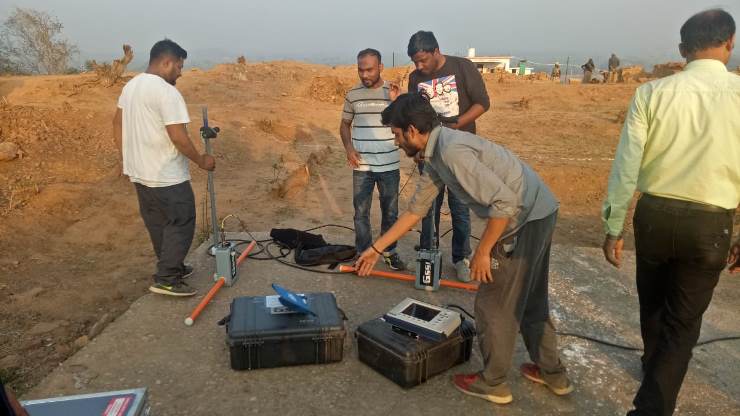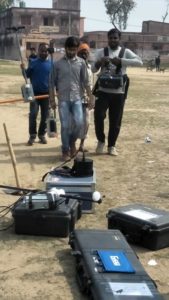Change font size -A A +A ++A

ISM, Dhanbad team conducting Geo physical survey at Lakhisarai.
Our Bureau/
For the first time in eastern parts of the country, Geo physical survey of the archaeological excavation has been conducted at Lali Paharia Jaynagar at Lakhisrari in Bihar to ascertain the positions of ancient historical remains inside the earth. Ongoing second phase of the excavation at Krimila (Lakhisarai), the erstwhile power center of Pala dynasty and also an important Buddhist center in India reportedly managed to trace huge structures of monuments buried below the earth there by the help of Geo physical survey.

Instruments for the survey.
“For the first time we are conducting the Geo physical survey to have the accuracy as well as the survey also helping us to perform the excavation appropriately and also to avoid any losses to the buried structures during excavation,” explain Prof. Anil Kumar, a senior teacher of faculty of history at Visva Bharati University and the team leader of Lali Pahari excavation.
Earlier in the joint venture of Bihar Virasat Vikash Samity and Visva Bharati University, the excavation at this site on November 26, 2017.

Team members to search buried structures.
According to Prof. Kumar the same survey has been done on several other mounds around Lakhisrari. He said that the Geo physical survey has been done with the joint collaboration with Indian school of mines (ISM), Dhanbad now IIT, under the supervision of Dr. Sanjeet Pal. “We are conducting the survey at the radius of 30 meter of any spot to have accurate findings below the earth,” he said.
The team from ISM, Dhanbad said that the team has been using ground penetrating radar (GPR), Electrical Resistivity Tomography, Magnetic and VLF (very low frequency electromagnetic and self potential method) to identify the old structures below the earth. “Several brick-structured buildings have

Searching at another site at Lakhisarai.
been scanned below the earth here,” a team member pointed out. He said that the Geo physical survey method is mainly used to identify mining ores like coal, iron etc below the earth before excavation. “Applying this method, now the task of excavation would become more easy here,” he pointed out.
Some broken rocks , the structures of monuments (Buddhists) have been recovered during excavation here recently. “After observing the broken edifices, one could easily assumed that the Buddhists monuments were broken ruthlessly in a planned way by the invaders”, claimed Prof. Kumar. But more interestingly, there is no historical evidences or any references of the incidents of destroying the monuments by the persons namely.

Evidence of destruction – the broken stones of Buddhist center at Lakhisarai.
Now with the broken structures found at Lakhisarai, it has been claimed that the erstwhile center of Buddhism was destroyed like Vikramshila or Nalanda Mahavihara. It is alleged that Muslim invader, Bakhatiar Khalji made an abortive attack on Nalanda mahavihara and proceeded further towards Bengal. Taking advantage of the favourable situation, the Turks of Bengal made a similar attack on Vikramshila Mahavihara and destroyed it. According to Prof. Kumar there is no specific evidences about the invaders who destroyed Krimila (Lakhisarai) Buddhist monuments.
However, he said that according to the description of Dharmaswami, a Tibetan scholar who visited different places in Bihar some year after the destruction of Vikramshila Buddha Mahavihara, sometime between AD 1234 and 1236, mentioned that the Buddhist center at Krimila (Lakhisarai) was

Excavation to locate ancient history at Lakhisarai.
destroyed by Muslim invaders. Dharmaswami had witnessed the ruins and collected versions of local people at the place when he was on way to Simaran Garh at Nepal from Bodh Gaya. Dhawmaswami crossed the Ganga river near Lakhisarai.
“Hope we would have more evidences in this course of excavation here to establishe the missing links of history,” Prof. Kumar said.



Leave a Reply